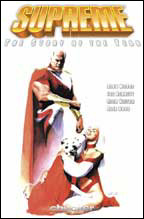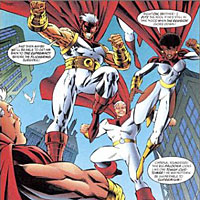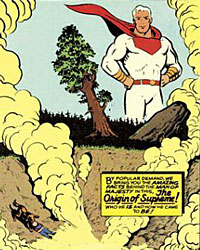>> The Friday Review: The Losers: Ante Up
>> The Friday Review: Marvels
More...

 Writer: Alan Moore
Writer: Alan Moore
Artists: Joe Bennett, Rick Veitch, Mark Pajarillo, Chris Sprouse, and others
Letters: Todd Klein
Colours: IHOC, Quantum FX, others
Collects SUPREME #41-52A/52B
Price: $26.95
Publisher: Checker Book Publishing Group
ISBN: 0971024952
Quoth Pop Will Eat Itself, once upon a time: "Alan Moore knows the score".
It's a lyric from their single 'Can U Dig It', which makes reference to a plenitude of other late-eighties pop-cultural artefacts. It's also thrown in - almost as an afterthought - with the introduction to SUPREME: STORY OF THE YEAR; as such, it tends to jar a little, when you consider Moore's career arc since the heady days of WATCHMEN.
While Moore was by no means wandering the comic-book wilderness following his departure from DC, as far as the wider public was concerned, Moore - the man who had made comic books over into semi-respectable graphic novels - had dropped out of sight. (Of course, those of us in the know understand that he was working on FROM HELL and becoming a practicing magician, among many other things.) Having been brought back into the mainstream at Todd McFarlane's behest, Moore felt it necessary to reintroduce himself to a readership that might not be familiar with his work. Thus, we saw the likes of SPAWN, VIOLATOR, WILDCATS, and even SPAWN/WILDCATS emanate from Moore's pen. (Just a quick word on the latter: it's best avoided. Seriously.)
Then Rob Liefeld came calling. With him, he brought his Superman knockoff, Supreme. And once Moore started working with the character, you'd be easily forgiven for thinking that it was the Silver Age once again. In the course of STORY OF THE YEAR, Moore re-examines all the goofy-yet-charming elements of those old comic books (animal sidekicks and the like) and reminds us why we liked them in the first place. What's more, he does it in such as way that maintains a respect for the source material, without denigrating it or the reader's fondness for it. If anything, Moore's just as enamoured of those ingredients as we might be.
Prior to Moore's handiwork on the title, SUPREME was - to be quite honest - a poor man's reworking of Superman as Liefeld imagined him: all attitude and no moral compunctions to hold him back. In short, the character completely missed the point.
 Moore ignored all prior continuity in one fell swoop, by having Supreme return from space to find that our planet is in dimensional flux, past and present overlapping. In the midst of his confusion, the Platinum Paragon is beset by alternate versions of himself: a 30s version, a future iteration, a 70s soul sister (complete with afro) - and Squeak the Supremouse.
Moore ignored all prior continuity in one fell swoop, by having Supreme return from space to find that our planet is in dimensional flux, past and present overlapping. In the midst of his confusion, the Platinum Paragon is beset by alternate versions of himself: a 30s version, a future iteration, a 70s soul sister (complete with afro) - and Squeak the Supremouse.
You may laugh, but in context, it makes perfect sense: these other versions have been sent to retrieve our present-day Supreme, and bring him back to the Supremacy, home to every possible Supreme variant extant. There, Supreme is informed of his origins - and his possible future, which he chooses to explore, thus setting up the dramatic arc for the stories collected here.
Along with the reader, Supreme discovers his background as Ethan Crane, soft-spoken comic-book artist for Dazzle Comics, in the city of Omegapolis. We witness his childhood in the small town of Littlehaven, his adventures alongside his female counterpart Suprema and the Allied Supermen of America, and his ongoing rivalry with the (supposedly) deceased evil scientist, Darius Dax. All familiar to us, and yet different; everything new is old again, to coin a phrase.
The events that unfold are played fairly straight, with a keen sense of amusement underlining developments, not unlike a fun-house mirror reflection of the aforementioned WATCHMEN. While sharing an affectation for the sillier elements of those older comic books (remember the elder Nite Owl's pet dog?), STORY OF THE YEAR deviates from Moore's earlier series in that such elements are honoured for what they are, as opposed to being presented as ironic commentary.
Conversely, Moore isn't motivated by nostalgia - at least, to the point of decrying all modern comic books as rubbish. Instead, he's drawing attention to the fact that such material served to fire the imagination of children the world over, despite the inherent silliness of such devices as flying citadels and extra-dimensional prisons.
Quite rightly, Moore's SUPREME is seen as a precursor to his ABC line, specifically what he would go on to attempt in the pages of TOM STRONG and TOP TEN - to hark back to a time when comics were seen as 'imagination reactors' and not simply disposable kiddie fodder.
 TOM STRONG uses the flashback technique pioneered in SUPREME - retelling past events by using the artistic styles of yesteryear - at which frequent Moore collaborator Rick Veitch excels. TOP TEN works on a deeper level as a meta-critique of the superhero comic, and the quieter moments in STORY OF THE YEAR showcase the beginnings of this line of thought, as we witness the exchanges between Ethan Crane and his Dazzle Comics co-workers.
TOM STRONG uses the flashback technique pioneered in SUPREME - retelling past events by using the artistic styles of yesteryear - at which frequent Moore collaborator Rick Veitch excels. TOP TEN works on a deeper level as a meta-critique of the superhero comic, and the quieter moments in STORY OF THE YEAR showcase the beginnings of this line of thought, as we witness the exchanges between Ethan Crane and his Dazzle Comics co-workers.
One instance has Billy Friday - a neurotic British comic book writer (aren't they all?) - trapped in the prism city of Amalynth; he deals with the situation by opting to report events in his own autobio comic book series. (To which Dazzle Comics editor-in-chief Lucas Tate responds: "I bet Shooter never thought of that!")
The ultimate selling point of STORY OF THE YEAR is just that: the story. Moore handles the metatextuality of Supreme's journey with deftness rarely seen in superhero comics. However, the accompanying artwork is something of a mixed bag. Veitch, as mentioned earlier, moves between the various old-school styles with a chameleon's ease, and is the definite highlight of the collection. One sequence has Veitch paying homage to the EC Bullpen of the fifties (the Wood/Kurtzman riff in 'Supremelvin' is a delight to behold), while another recalls the cosmic ponderousness of 70's comics with skill and detail. The depictions of present day narrative, though, ranges from good (Chris Sprouse's 'talking heads' sequence) to adequate (Bennett & Rich Horie) to subpar (Mark Pajarillo, whose sense of perspective appears to be way off).
As for the presentation - much has been made about the poor quality of the reproduction, as scans of the original comics were used, resulting in obvious pixelization and moire. It's glaringly obvious at points, but once you get caught up in the narrative, it won't matter overmuch. The inclusion of sketches by Alex Ross is a nice touch (if a little superfluous), but the misguided biographies on the back cover of my copy strike me as hastily researched. (I understand this has been rectified for later printings.)
With MIRACLEMAN and CAPTAIN BRITAIN in the early 1980s, Moore began the deconstruction of the superhero, which WATCHMEN took to the limit. SUPREME: THE STORY OF THE YEAR, however, sees Moore - in a sense - come full circle. Moore credits Harvey Kurtzman's MAD parody 'Superduperman' as the reactor that fired up his thinking about superheroes. Having Moore and Veitch pay homage to that (as noted above) is just one of many small moments that make the whole work.
While not a book one would call 'deep', this does manage to be fun while provoking thought on the evolution of the genre. And yes, STORY OF THE YEAR is an ostentatious title, but after reading it, you may well agree that it is the case - if not for this year, then perhaps for yesteryear.

This article is Ideological Freeware. The author grants permission for its reproduction and redistribution by private individuals on condition that the author and source of the article are clearly shown, no charge is made, and the whole article is reproduced intact, including this notice.


